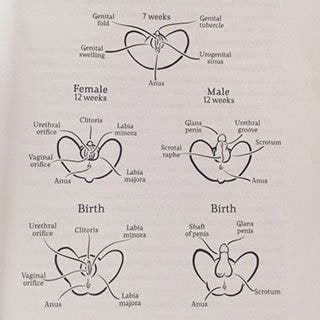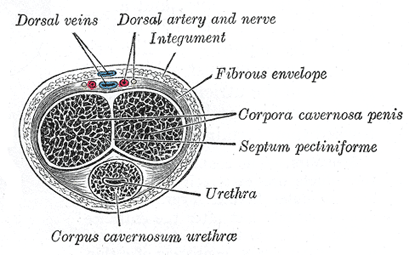Clitoral Erections Are REAL — And Here's How To Have One
Explore your pleasure potential!
 weheartit
weheartit The more you understand how to stimulate the internal erectile tissue and outer structure of the genitals, the more sensation, genital health, orgasmic pleasure and relationship harmony you can experience.
Her clitoris is just the tip of the iceberg.
Okay, okay… so maybe "iceberg" isn't the best metaphor given the hot, explosive eruption women can experience with orgasms.
But there is no word for the tip of a volcano because when a volcano explodes, the tip explodes with it. Which, come to think of it, is an apt metaphor for the ultimate release that is possible with orgasm (i.e. your mind gets blown and all of your mental stress burns away in flames of ecstasy).
That is the beauty of human sexuality: it’s an exquisite, inbuilt, stress-release system.
And the hormones released during intimacy calm our nervous systems and make us feel loved and connected.
To optimize the potential of your orgasmic pleasure — or your partner's — you’ll want to know the secrets about the female sexual anatomy that very few women and even fewer men know about.
Countless women who "take too long to come" have started having full body orgasms once they — and their lovers —absorb this information and learn to stimulate her genitalia in all their fullness.
The truth is, most women (and most men) experience only a fraction of their sexual pleasure potential. And to understand why, here is a short sexual anatomy lesson.
NOTE: this lesson is as relevant to a men’s sexuality as it is to a woman’s because male and female genitalia are homologous, i.e..: our sex organs are, in a certain sense, the same.
The word homologous comes from the Latin for "agreeing." The root homo- means "same." In biology, homologous refers to structures or tissues that have a common origin but develop in different ways.
Our sex organs are more similar than different. And the most important piece of information I can tell you that will have the biggest impact on the amount of pleasure you give and receive revolves around giving HER an erection.
It’s pretty obvious that men have erectile tissue; when you stroke it, it swells with blood (called engorgement).
What isn’t as obvious is that a woman’s sex organs also get engorged and become "erect." Even more exciting: both a man’s penis and a woman’s clitoral system have root structures that extend deep INSIDE the body.
The more you understand how to stimulate the internal erectile tissue and the outer structure of the genitals, the more sensation, genital health, orgasmic pleasure and relationship harmony you can experience.
In Come As You Are: The Surprising New Science That Will Transform Your Sex Life, Dr. Emily Nagoski explains how everyone’s sex organs start out the same until the fetus is six weeks old at which time hormones release and cause us to become male or female.

Come As You Are
Said simply: Men and women have the same parts, they are just organized in different ways.
We all start out in the womb with the same genital tissue. Each part of our sex organs are similar in position, structure, and origin, but they have different functions.
Understand these four key areas of the genitals and you’ll know where to stroke, lick and stimulate to increase engorgement to maximize pleasure.
Giving a woman enough stimulation to actually engorge her whole clitoral structure may mean the difference between her orgasming easily or not… Or becoming multi-orgasmic instead of being a one-and-done comer.
Let’s plunder the buried treasure hidden inside her. Here are four key areas where we are similar and WHICH like stimulation:
1. Female Clitoris and Male Penis
The clitoris is composed of three chambers which extend deep into the body: a pair of legs (crura) that extend within the tissue of the vulva, and the bulbs of the vestibule.
The penis is composed of three chambers which extend deep into the body as well: a pair of cavernous bodies (corpora cavernosa) and a spongy body (corpus spongiosum). Female crura (clit legs) and male corpora cavernosa (penis shaft) share the same origin. Likewise female bulbs of the vestibule (labia majora) and male corpus spongiosum.
You wouldn’t just rub the tip of a penis to get it erect. So you can’t just rub the clitoral glans and expect her clitoral structure to get engorged.
Focusing on the crura and vestibular bulbs when stimulating her will cause her clitoral structure to get engorged.
To do this, you rub inside her vaginal canal and underneath the skin where the pubic hair grows. Rub, knead, lick, suck — get feedback about what feels good to her.
Here’s another vital piece of information…
A woman’s G-Spot, which is NOT a spot but rather an area, is actually a tube of tissue that surrounds her urethra. Her urethra is the tube out of which both her pee and part of her female ejaculation fluid express.
This sponge is made of erectile tissue. It loves to be stroked to engorgement. Rub the roof of her vaginal canal with your tongue, fingers, penis or a toy to engorge it and give her a clitoral erection.

This is like a man’s corpus spongiosum, which is the tube that runs down the shaft of his penis and surrounds his urethra out of which both his ejaculate and pee come.
See how alike we are?
2. Female Labia Majora (outer lips with the pubic hair) and Male Scrotum (balls)
These structures are visible and obvious; most people have a pretty good sense of the sensations and pleasures associated with them.
But if you’re not palpating and pressing on her bulbs (under her pubic hair on each side of her vaginal opening) then you are missing out on an incredible amount of additional pleasure.
These are the little punching bags that hang down under her clit legs in the image below. Plump those bulbs up — the labia majora — and she will come better.
What you may not know is that the seam running up a man’s balls, the scrotal raphe, is the same tissue that would have split into labia if he had been a she. This is also why men have nipples even though women are the ones who use them to breastfeed.
3. Female Clitoral Hood and Male Foreskin
These "coverings" protect the super-sensitive tissue beneath. These tissues have more nerve endings than any other part of the body. Men who have been circumcised retain a high degree of sensitivity where the head meets the shaft.
Stimulating the clitoral hood above the clitoris can help engorge it and give her a clitoral erection.
With enough stimulation, the clitoris gets erect and you can roll the stalk of the clit between your fingers to further engorge it.
4. Female Fourchette and Male Frenulum
The Fourchette (also called the frenulum labium) is where the labia minora meet at the bottom of the vaginal opening, near the perineum. The labia minora goes from the clitorial hood all the way down to the Fourchette.
This feels sensational to be licked and stroked on a woman. It will get plump with engorgement from stimulation and the skin will darken in color as the blood fills this tissue.
The male counterpart is the frenulum: the delta of tissue on the underside of the penis where the head meets the shaft. Men love to have this highly sensitive area licked during oral sex.
Here’s the key takeaway from this anatomy lesson: most of us only experience a fraction of our pleasure potential. Our sex organs have a tremendous amount of highly sensitive erectile tissue buried inside our bodies.
The root of the penis goes deep inside his body. With stimulation, that root will get engorged and make his penis longer and firmer too.
If you’ve been clit-centric or playing primarily with the head and shaft of his cock, start to explore what’s below the surface.
You can dramatically increase both your pleasure and the intensity of orgasms — both his and hers — by involving the deep sexual anatomy.
Susan Bratton is a trusted sex advisor to millions. Download her complimentary stroke technique guide, Female Genitalia: Anatomy & Engorgement.
YourTango may earn an affiliate commission if you buy something through links featured in this article.

